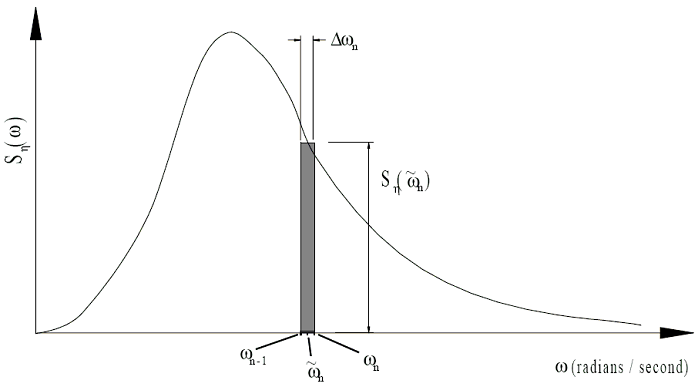This section discusses how the water surface elevation is found at any point in the wave field.
As described in Spectrum Discretisation, a random sea is discretised into component harmonics. The output from this process is essentially a series of regular waves, each with its individual period, amplitude and phase. For a multi-directional random sea, the resulting water surface elevation at a point in the wave field is found as a superposition of these wave components over all wave directions and is given by the equation:
![]()
where:
•![]() is the wave amplitude in mth direction of nth harmonic
is the wave amplitude in mth direction of nth harmonic
•![]() is the wave number of nth harmonic
is the wave number of nth harmonic
•![]() is the horizontal distance in mth direction from vertical axis Y=Z=0 to point in question
is the horizontal distance in mth direction from vertical axis Y=Z=0 to point in question ![]()
•![]() is the angle of mth wave direction measured anticlockwise relative to global Y
is the angle of mth wave direction measured anticlockwise relative to global Y
•![]() is the random phase for mth wave direction and nth harmonic
is the random phase for mth wave direction and nth harmonic
•![]() is the number of harmonics
is the number of harmonics
•![]() is the number of wave directions
is the number of wave directions
For a uni-directional random sea, obviously ![]() , and the above Equation becomes:
, and the above Equation becomes:
![]()
For a uni-directional random sea, the coefficients ![]() are found from the wave spectrum
are found from the wave spectrum ![]() using the relation:
using the relation:
![]()
where:
![]()
![]()
The product ![]() is an increment of the area under the spectrum centred on
is an increment of the area under the spectrum centred on ![]() , as shown in the below figure.
, as shown in the below figure.

Spectrum Area Increment
The wave amplitudes ![]() for a multi-directional random sea are related to the uni-directional values
for a multi-directional random sea are related to the uni-directional values ![]() as follows:
as follows:

where:
•![]() a spreading function used to distribute wave energy about the dominant direction, as described earlier in the ‘Wave Energy Spreading’ section.
a spreading function used to distribute wave energy about the dominant direction, as described earlier in the ‘Wave Energy Spreading’ section.
•![]() is the mth wave direction relative to dominant wave direction
is the mth wave direction relative to dominant wave direction
•![]() is the direction relative to dominant wave direction
is the direction relative to dominant wave direction